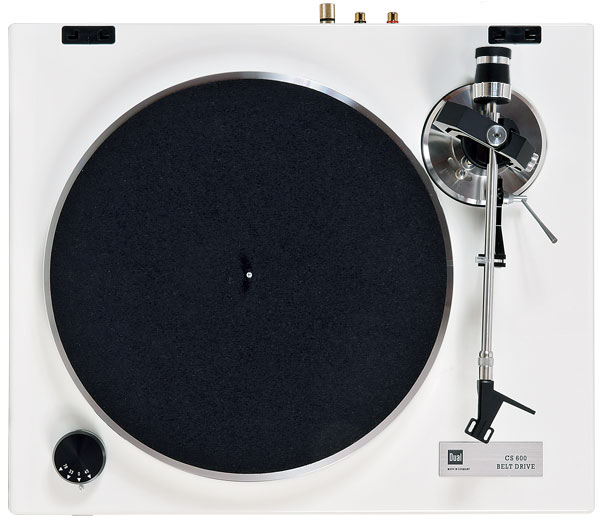Dual CS 600 Turntable Page 2
![]() Blasts From The Past
Blasts From The Past
While it's true my initial experience with the CS 600 did not cause me to reminisce any further about the idler-drive Dual 1019 of my youth, it did make me recall my late-1970s Rega Planar 2. Headshell aside, the no-nonsense simplicity here, the lack of a fiddly suspension to adjust, the minimalist styling: for looks and ergonomics, it adhered to the genius of the Rega template of over 40 years ago.
Sonically, too, it was Rega-esque, and in a good way. The sound was light, especially when compared to turntables with platters that weigh as much as a small fridge, but still lively and involving. I know the cartridge intimately, and I have heard it sound better all-round, but as I cannot separate the tonearm from the deck, I don't know exactly which element of the CS 600 package to blame for the slight loss of cohesion. But I have my suspicions…
Listening to Lightnin' Hopkins' open, airy and natural 1963 recording, Goin' Away [Bluesville/Analogue Productions 1073], enough of the sense of both space and soundstage dimensionality were present to identify the portrayal as above entry-level. It wasn't quite as visceral as I know it to be, but the details were recovered with minimal smearing or concealment, while the scale was suitably correct in its intimacy and there was impact a'plenty.
Free For All
Veteran rural blues singers like Hopkins are identified by their vocal textures, which contrast beautifully with the trebly twang of a guitar. This magic also describes the appeal of John Lee Hooker and too many others to list. Underneath it all, Hopkins' lean trio was completed with drums and bass, the latter enjoying sufficient, if not overwhelming mass. Fortuitously, the drums had that wonderful, cheesy, papery sound that was favoured by blues bands of the era, adding urban snap to what sounds fundamentally rural rather than uptown. Here the CS 600 rose to the occasion, reproducing this with almost enough authority to defuse my angst.

Goin' Away, however, is so superbly recorded (and in this case, mastered and pressed) that it qualifies as an audiophile recording of the calibre that makes any system sound better than it might be. And so I turned to the opposite: Sun Ra's Pathways To Unknown Worlds [Modern Harmonic MH-8084]. Generously described by one source as a 'sonic free-for-all', this is the kind of improvisational jazz that would have some listeners begging for a reprieve, or a power cut at the very least, but dull it is not.
Punchy Brass
With this release, the CS 600 had to deal with speedy transients, cacophony, a variety of textures, bizarre image placement and other elements that I had heard only the day before on a state-of-the-art system. Blessedly, this latest Dual turntable held it all together, especially the punchy brass, honking saxes and multiple congas.
As if to disprove any ingrained audiophile beliefs that tonearm rigidity, arm structure integrity and other mechanical issues matter, the requisite attack was precise throughout, from instrument to instrument. What's more, the bizarre tonal colourings present on this 1973 recording retained their individual characteristics.
Returning to earth – and that is more apt a statement than you might think, given Sun Ra's interstellar karma – I turned to the superlative remastering of The Beatles' eponymous White Album [Universal/Apple 02567 57201]. I must admit that I am still growing accustomed to its sound, to the discovery of previously hidden details and other boons to the masterpiece courtesy of Giles Martin. But the two most overwhelming characteristics are the lower registers and the sheer scale of the soundstage.
This doesn't apply only to the epic, hard-rocking or grandiose tracks, but equally to the more delicate numbers including 'I Will', 'Blackbird' and 'Julia'. This is an album I have heard so many times, and possess in at least 15 versions, that I was unprepared for the shocks and surprises of the remastering the first time I heard it. The CS 600 attempts to reproduce this with reasonable success, even if much of the majesty slips its grasp.
While soundstage width was spot-on, front-to-back stage depth seemed flattened. The bass only went so far, and I know the Jo No5 cartridge had no trouble with it in my reference turntable. But the flagship CS 600 has no aspirations to 'reference' status. Instead, it is a stepping stone for any audiophile that aspires to the ownership of a truly high-end system.
Hi-Fi News Verdict
First things first: the CS 600's headshell set-up demands both concentration and patience – in spades. That aside, once this deck was up and running it proved a solid performer, delivering sufficient slam when required, conveying the individual characteristics of instruments in even the busiest of mixes and shining when it came to soundstage width. Nevertheless, it's a tough market out there...


















































